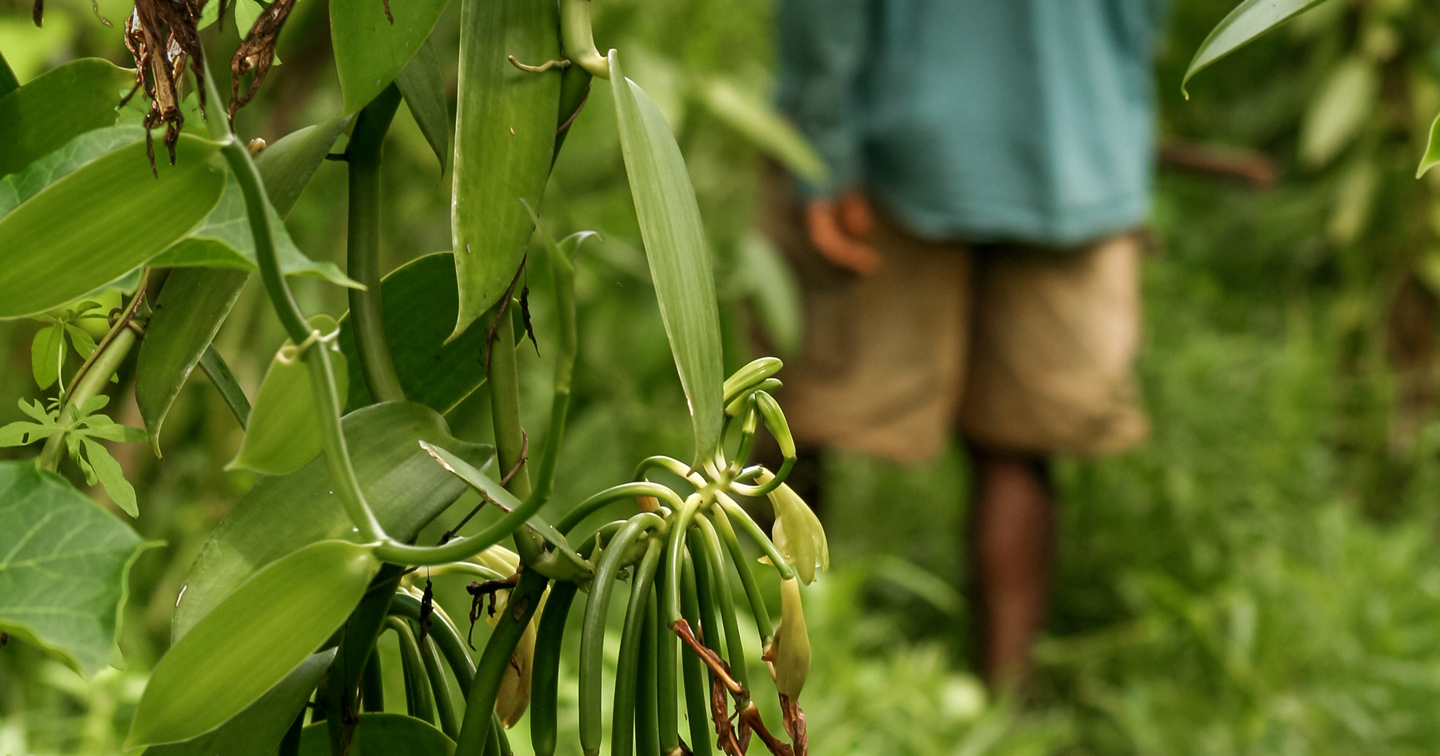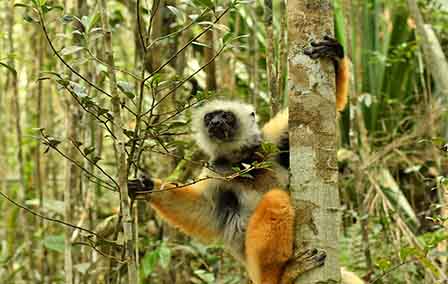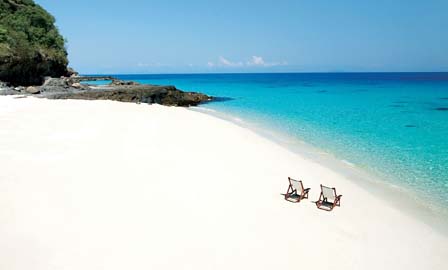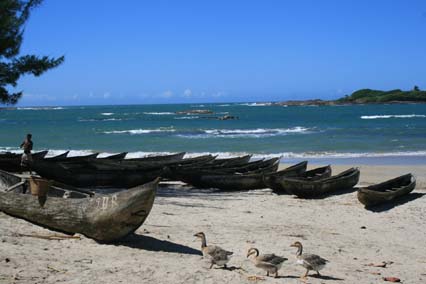Published 28th Jun. 2021
Reading time
Madagascar is the fourth largest island in the world and a mere 250 miles off the coast of mainland Africa but it still remains a largely undiscovered corner of the continent. I've just returned and can really only describe it as the most fascinating and beautiful country I've ever been to. It is a place that completely has its own vibe; it's not African, or Asian or European but then, at the same time, it is all those things...
Most travel in Madagascar is dictated by flights and, more specifically, Air Madagascar (an airline that epitomises the word awkward in terms of timings, airport names, codes and general aviation-ness) so a night in the capital Antananarivo or Tana, as it's called locally, is inevitable.
I started my trip proper in Antisiranana in the North which meant a very early morning flight from Tana (torch and bug spray are essential). The main attraction here is the Amber Mountain National Park which is absolutely beautiful - Jurassic ferns everywhere and I got some wonderful lemur and chameleon sightings.
Interesting facts I learnt:
I had a brilliant guide named Angelou who, incidentally, has a twin called Angelique and the two are international experts on reptiles and helped David Attenborough with his recent Madagascar programme. We saw lots of lemur, a beautiful sacred waterfall and the lake. The Nature lodge where I stayed had amazing views of the mountains and the Bay of Diego, as well as a lovely garden. The Nature Lodge comprises 12 little wooden bungalows - really sweet, clean comfortable.
On the drive to Ankarana we stopped at Red Tsingy (a red clay phenomenon caused by deforestation) which is amazing. Its was a long drive to Ankarana, mostly due to the fact the roads are so bad - but quite beautiful - amazing colours as the surrounding rice paddy fields are wonderfully lush and you pass all sorts of different eco-systems.
Ankarana National Park - the main attraction here is the black tsingy, a huge bat cave. The noise might be slightly terrifying if you're not that into bats but it feels a bit like you are in an Indiana Jones film.
From the bat caves, we then drove to Ankify - again a stunning drive through y'lang-y'lang and cocoa plantations, before taking a speedboat transfer to Tsara Komba Lodge.
Heaven. Tsara Komba Lodge has beautiful thatched rooms built into the hillside on a really lovely stretch of beach. The rooms are huge with massive private decks and private sun loungers. It is all as open or closed as you want it to be - no one can see in to anyone else's room. I particularly liked the cool stone and driftwood bathroom and the bed was huge. The sea here is the most perfect temperature. There are loads of activities to keep you busy including snorkelling, pétanque, fishing, island hopping and kayaking. I enjoyed delicious food in the really beautifully done restaurant and the bar area was great - old leather chairs and lovely stone ornaments.
I then headed to Tsarabanjina, a small island off Madagascar's north west coast, via a 1 hour speedboat transfer to Mitsio Archipelago. All the resort's staff line up on the beach and wave at you as you arrive - amazing! The whole place was so unbelievably beautiful; the sea is so turquoise and the sand is white white white - truly like a dream. Everything is built into these amazing rocks which you can climb over to get around the whole island. My hut on the South Beach was right in the middle but still felt very private. Everything about the actual lodge is very subtle - the restaurant and rooms really don't look like much more than beach huts until you are inside. Rock formations known as the Four Brothers are ever-present in the distance and give it a Neverland feel. The diving here is wonderful and I dived around two of the Four Brother rocks - beautiful coral and great visibility; I saw puffer fish, whale shark and clown fish.
The island is also home to a team of brilliant masseurs if you're feeling indulgent and in need of relaxation. If you want to get active there's lots to do and there is even an activity host who comes to quietly ask if you would like to do any or all of them! Activities include a sundowner boat ride, snorkelling, Zumba, ping pong, volley ball, diving and helicopter trips from the resort's own heli pad.
Travel Tip: Walk around the island to find a private little bay, don't just stick to the one by your room. Rooms are set on the south and north beach - the north is possibly a bit more beautiful and some of the rooms are raised with a little deck overlooking the beach, whereas rooms to the south are all on the beach and get the sun all day. Both are pretty incredible to be honest!
This is a really sweet boutique hotel, built in the 1930s, but it's very creaky. The main lounge and restaurant are really fun - it's like a little old tearoom with lots of chintz velvet chairs, floral teacups, a gramophone, grandfather clock etc. I was in the English suite which is lovely and has a balcony and a lovely tiled bathroom, with stand-alone bath and old school bubble bath in big glass bottles with glass stoppers.
I was met upon arrival on Sainte Marie Island by Princess Bora staff and then transferred to the hotel by ox-cart - quite a fun way of doing it but unfortunately it was raining so was a bit miserable! I was, however, upgraded to an Executive Suite which was incredible, great for honeymooners with a HUGE sunken bath and twin showers. The room had lovely high ceilings and all around the bed was glass so the room felt very open and light. I also had my own private deck overlooking the beach - heaven.
In terms of food, there's a restaurant by the pool; the chef uses only local, seasonal ingredients which is great. The lodge has a Jungle Spa where you can enjoy a variety of treatments and can even make your own oil in the 'experiment room'. There are also lots of activities available here - diving, cycling, quad biking, moped tours - this is very much a place to come to get a feel for Malagasy people and coastal life. Everyone is really friendly and it has a completely different feel to the beaches of the North, it is much more like the Caribbean - very lush.
I continued my journey south to Toamasina, often know as Tamatave. I took a very, very wet boat down the Panagalan canal which was fun and interesting in spite of the rain; you pass amazing rainforests on either side, lots of little fishing villages and fishermen in dug-out canoes.
Travel Tip: Bring waterproofs if you're going to do this as the trip is about 2 and half hours long.
I arrived to the cool wooden pontoon and sandy beach of the Palmarium Reserve. The rooms are quite basic but very spacious and perfectly fine for one night. There were lemurs everywhere that will come and eat with you (and for you). A great activity here is a night time expedition to Aye Aye Island - the only place in the world to see the aye aye lemur. They are incredibly rare (and incredibly ugly) but the island is just a short boat ride away and well worth the visit.
From the Palmarium Reserve I headed to Andasibe National Park, which is about a 3 hour drive away. Here you can see indri lemur, golden lemur and dancing lemur. It's very beautiful and I had a nice walk with and extremely knowledgeable guide. I stayed in the Vakona Forest Lodge - a big and pretty impersonal hotel but it has all you need. Rooms include a radiator (key for drying things off) and hot water (key for warming up a bit!). The restaurant is set on the lake and the grounds are beautiful. There's a fun night walk just before supper which is worth doing.
I then headed to the very south of Madagascar, to Mandrare, where I stayed in the Mandrare River Camp. You can charter a flight from Fort Dauphin to get there but I drove which took me from the seashore and through the mountains. Again, everything was very lush and green to begin with and then got much drier and dustier beyond the mountains. We passed lots of zebu herders on our way. Zebu is the most important animal to the people of this area and a boy as young as 6 can be in charge of a herd of 8. You are constantly seeing lots of little waving sticks with tiny people attached trying to herd zebu across the road. The number of zebu someone owns is also a mark of their status within the community. Some tribes won't let their men be married until they have managed to steal a zebu from another man, and they're definitely not allowed to marry if they don't own any at all! The Mandrare River Camp is next to a huge sisal plantation. Sisal is a species of Agave which yields a type of fibre - it is harvested in families and so the more children people have, the more they are able to harvest.
Upon arrival at the camp, I was treated to an amazing cultural dance which was full of energy and powerful story telling - a lot of the locals come and watch this too as they are extremely proud of their culture and the fact that they can share it. The Camp is really lovely (the food, in particular, was great); it overlooks the Mandrare River and has access to two main forests: Spiny and Gallery.
I enjoyed a long walk in the Gallery Forest in the morning before having lunch under the tamarind trees. The forest is sacred so rules apply: no pointing with your index finger, no picking things up and no going to the loo in the forest. Lots to see - chameleon, ringtail lemur (aka King Julian in the animated Madagascar films), boa snakes, beautiful trees. In the afternoon I toured a couple of the local villages and was fascinated to see the cultural side of things.
We then drove to the Spiny Forest for sunset, which was followed by a night walk. Spiny Forest is quite eerie, but fascinating, there were lots of mouse lemur and I really enjoyed the walk. At supper we heard gunshots, which the local villagers use to announce a funeral, and the neighbouring village then responds with a gunshot of their own to show that they have heard and are on their way. The whole process can last up to 3 months because the family have to wait for all the relatives to arrive.
I flew from Mandrare back to Fort Dauphin and then drove to Manafiafy Beach and Rainforest Lodge. Another very bumpy road trip but, again, it was a beautiful drive with lots of changing scenery and little villages. I stopped at the local fish market to buy supper for the evening. All the fisherman have large dug out canoes, filled with their morning catch, which they line up on the beach. The hotel is on the coast and a lovely chill out option after Mandrare. The rooms are large and have private decks, from which you can walk to the beach. There are a lot of activities to do here - kayaking with a guide, snorkelling in the mangroves, visiting the local Manafiafy village and fish market, as well as nature walks.

Travelling with us means enjoying a trip that has been meticulously crafted by our team of experts, each knowing their specialised country like the back of their hand. Tailor-made with originality, quality and cultural immersion in mind, we can customise itineraries based on your taste, be that an architecture aficionado, a food fanatic or an environment enthusiast. Working hand-in-hand with local Concierges and guides, we’ll uncover spots perfect for you. From hidden gems to iconic landmarks, our curated experiences are supported by an array of additional services, including a 24-hour helpline and an app full of recommendations.
ENQUIRE NOWPractical advice and inspiration for your next trip

Madagascar can often feel like the forgotten member of Africa’s boy band. Slotting into the same category as George Harrison, John Deacon and Charlie Watts, it has long been happy for its front men, namely Morocco, Egypt and South Africa, to steal the show. Yet, as the fourth largest island in the world, home to 5% of all known animal and plant species, it could only be expected to hang backstage for so long.
28th November 2022 - Madagascar Safari & Wildlife

Constance Tsarabanjina Just off Madagascar's north coast, this ultra relaxed hideaway in the Mitsio Archipelago is the definition of a Robinson Crusoe island. 25 thatched bungalows with uninterrupted views of the ocean are spread along the north and south beaches under shady palms, and a hammock rests in the corner of the private verandas. Each bungalow has been built using locally sourced materials and tastefully decorated with Madagascan artefacts.
28th June 2021 - Madagascar Hotels

Madagascar is the fourth largest island in the world and a mere 250 miles off the coast of mainland Africa but it still remains a largely undiscovered corner of the continent. I've just returned and can really only describe it as the most fascinating and beautiful country I've ever been to. It is a place that completely has its own vibe; it's not African, or Asian or European but then, at the same time, it is all those things.
28th June 2021 - Madagascar Adventure

Our team of destination experts will get to know you and your unique requirements for your holiday

We work with you to build an ultra-personalised holiday itinerary with your choice of accommodation, experiences and activities

All of our holidays include little extras designed to make a big difference to your trip, from fast-tracking you through airport check-in and security to our network of local Concierges